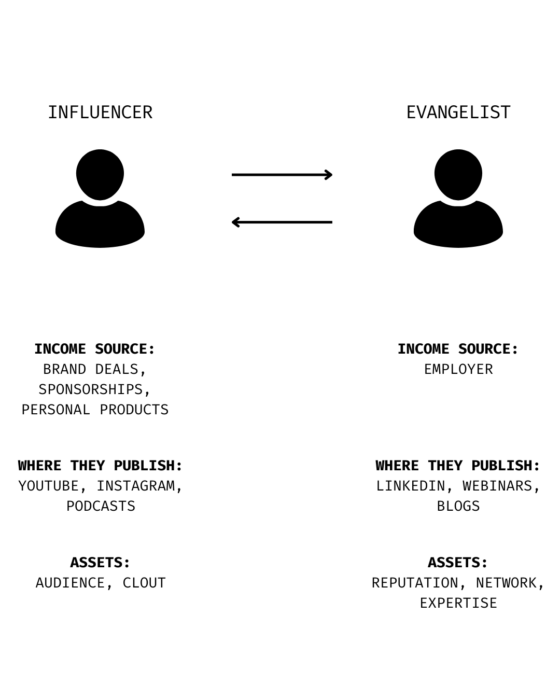Today, nearly everyone in your company needs to become an evangelist, publicizing and advocating for the company in the public domain.
We’re also beginning to see a real blurring of the lines between “influencers” and “evangelists” (as I define the term, which is basically a B2B influencer working for a company).

Imagine this: in the future, companies will hire influencers to be part-time evangelists, and will free up salaried employees to go generate influence on their personal name serving as a liaison to the brand.
Evangelists and employees will do this indirectly, without pushing product but instead by providing value. The best ones will be compensated for who they are, who they know, and the attention they control . . . not so much for what they do.
As the race to own mindshare continues to intensify, and as the Internet becomes more cluttered, we will begin to see more brands urging employees to speak their truth (not to withhold it) on social media – a stark contrast from years past.
I think in ten years, almost everyone will have their own podcast, just the same way everyone has their own LinkedIn or Instagram or Twitter profile today.
Those who do can serve as nodes across a net, subtly pushing and promoting the companies who employ or contract them.
From an employability standpoint, there’s discernible value in someone who has their own podcast, blog, and audience and who’s willing to serve as an extension of a brand – even if in a contractual capacity (e.g., “promote us for a one-month period with native shout-outs and topical episodes).
I also foresee something else on the horizon: an inversion of the typical content team structure. The way in which savvy companies run their content program is going to change – at least for select brands who understand that the more (good) content they can release, the better.
There is often a lot of stored knowledge hiding within employees’ minds which never sees the light of day. There’s a real opportunity to release those dormant insights by moving to what I call a “decentralized” or distributed publishing house. To its extreme, we’re talking about an almost “open source” content hub where every employee is able to – expected to – set up a profile and publish content.
You might have an editor-in-chief or a content manager at the helm. But instead of that person running a content team of three or five people (like years past), their role will switch to a facilitator more than a marketer.
Instead of writing up 101-level blog articles they have no business writing anyway, their role will involve triaging and orchestrating the twenty or sixty or hundred-plus contributors who make up the new democratized newsroom.
If I were advising a scale-up B2B brand, I’d actually take it a step further.
As a condition of employment, every employee would be expected to write or record content pertinent to their function. I’d hire one editor in chief to run the show, then rely on my extended team to source relevant content as in-house “reporters.” I’d help everyone understand that content, not product, sits at the core of successful organizations today and that it’s through content than the company can gain mindshare. That’s not to dismiss the importance of having a great product; it’s to say that now, you need both a great product and great content.
In a creator-centric model, the system constraint is the capacity (and knowledge base) of the team responsible for creating content. With a company-centric newsroom, there is no constraint.

This would simultaneously achieve three things. It would release captive insights held by SMEs who may otherwise have no inclination to let it out; it would enable exhaustive, end-to-end knowledge sharing not just for audiences but also for the benefit of the company; and it’d turn the content function into a massive media machine instead of a doctored marketing mishegoss.
Then, I’d encourage each member of the team to get active on social media. I’d bring in personal branding coaches to teach them how to build profiles that pop. I’d create a brand guidelines document to set a few standards. I’d create a Slack channel for people to drop their articles or videos or podcasts so everyone else could engage with them. And I’d urge my entire team to go get interviewed on literally as many other people’s shows as humanly possible.
I look at a platform like this, CustomerThink.com, which serves as a decentralized hub where many authors share space under the umbrella. There’s no editorial calendar. No (strictly) censored content – no “you can write about this but not that.” Every company needs to create their own “CustomerThink.com” and get their team participating in content creation on, and off, it.
This melding of influencers and evangelists, along with the evolution of decentralized branded newsrooms will dictate much of what the next ten years of marketing will look like. I think it’s only the beginning, too.
I discuss these concepts at length in my upcoming book, CONTENT CAPITALIST, set to release April 16. It’s on pre-sale now if you’d like to grab a copy.



